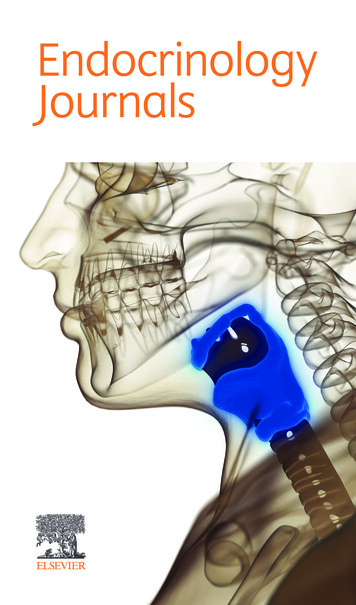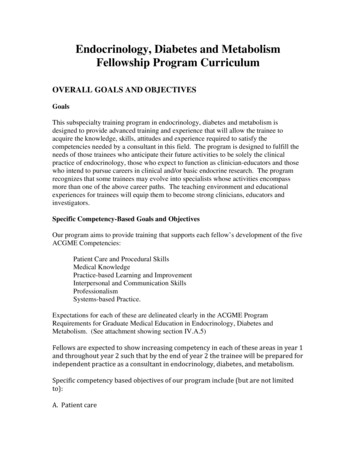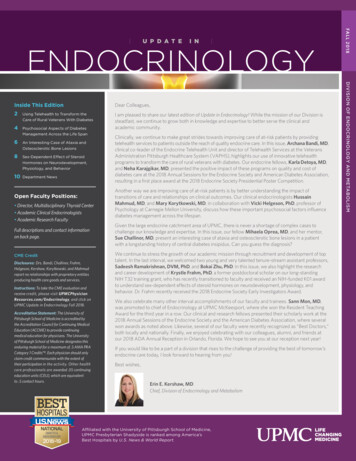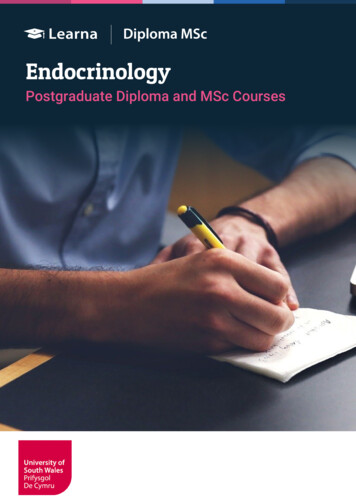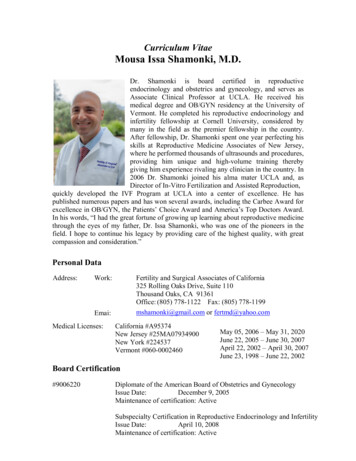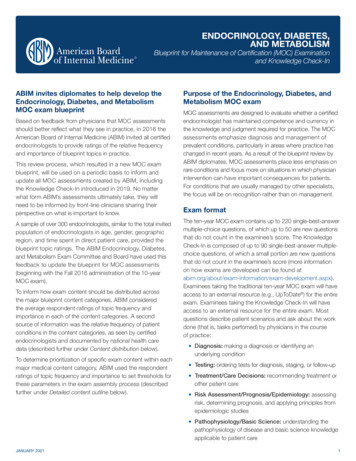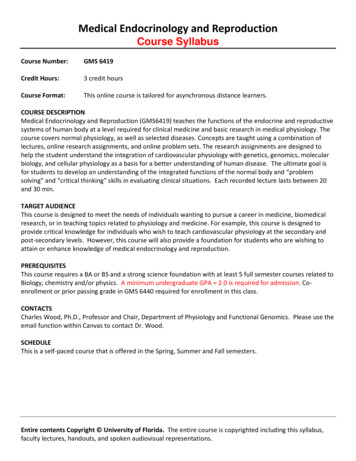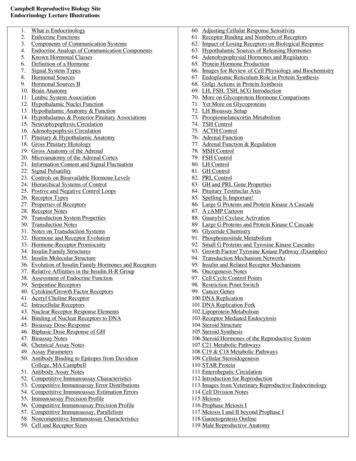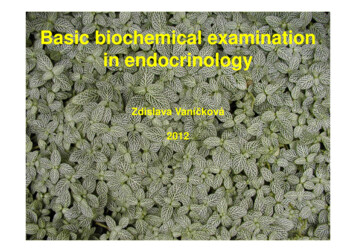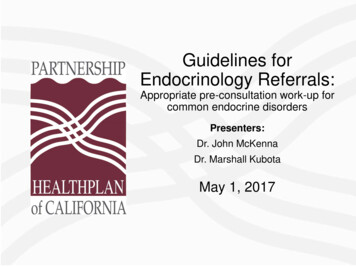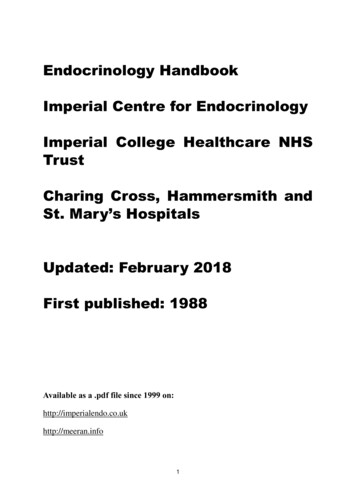
Transcription
Endocrinology HandbookImperial Centre for EndocrinologyImperial College Healthcare NHSTrustCharing Cross, Hammersmith andSt. Mary’s HospitalsUpdated: February 2018First published: 1988Available as a .pdf file since 1999 on:http://imperialendo.co.ukhttp://meeran.info1
INTRODUCTIONDiagnosis and appropriate treatment in clinical endocrinology rely heavily on the accurate use andinterpretation of diagnostic tests. This handbook was devised as a means of guiding new junior staff(and refreshing the memories of their seniors!) when confronted by clinical problems and theirinvestigation. This bible is meant to be brief and didactic with the inevitable costs as well as benefits ofsuch an approach. It is envisaged that it will be reprinted at 6 monthly intervals incorporating correctionsand additions, any suggestions and comments from readers are welcome.Grateful acknowledgements are due to: Professor Sir Stephen Bloom, Dr Simon Wallis, ProfessorGraham Joplin, Professor Kaye Ibbertson, Dr James Jackson, Dr Jacky Burrin, Mrs Veronica Ferguson,Mr Stuart Lavery, Mr Paul Bains, Dr Emma Walker, Dr Alexander Comninos and all our colleagues fortheir help and encouragement.We are delighted to note that this handbook is forming the basis of many endocrine protocols on variouswebsite around the country. The first version of this was written by the registrars and consultants in theEndocrine Unit in 1988 and used as a handbook for the junior doctors ever since. It has been availableon the web since 1999 and it has since been widely used as the central source of endocrine protocolsever since. Please feel free to use this information to educate your own staff, and please simplyacknowledge the Imperial Centre for Endocrinology.IMPORTANT NOTE: Any reference ranges provided apply specifically to Imperial College HealthcareNHS Trust (ICHNT). If using this resource at a difference centre, please check your local lab's referenceranges.2
AUTHORSSarah AliChanna JayasenaMatthew AllumBen JonesMaha BarakatBernard KhooMaria BarnardCarl Le RouxSophie BarnesNiamh MartinDuncan BassettKarim MeeranRachel BatterhamElaine MurphyPreeshila BeharyNick OliverNicola BridgesFausto PalazzoAdam BuckleyArshia PanahlooJaimini CeglaDebbie PetersHarvinder ChahalMichela RossiAlexander ComninosAmir SamGerry ConwayLeighton SealJaideep DhariwalMano SiraWaljit DhilloSarah StanleyAgnieska FalinszkaTricia TanJohn FrankGeorge TharakanStephen GilbeyJeannie ToddTony GoldstoneEmma WalkerSaira HameedJulian WaungPeter HammondFlorian WernigEmma HatfieldJohn WildingAndrew HattersleyMatt WilliamsChioma Izzi-EngbeayaZarni WinSheba JarvisSagen Zac-Varghese3
CONTENTSINTRODUCTION. 2AUTHORS . 3CONTENTS. 4ANTERIOR PITUITARY . 10ANTERIOR PITUITARY FUNCTION . 10INSULIN TOLERANCE TEST (ITT). 10GLUCAGON TEST . 14METYRAPONE SUPPRESSION TEST . 16THYROTROPHIN RELEASING HORMONE (TRH) TEST . 18GONADOTROPHIN RELEASING HORMONE GNRH/LHRH TEST . 19COMBINED PITUITARY FUNCTION TESTS (CPT). 20VISUAL FIELD TESTING (GOLDMANN AND HUMPHREYS PERIMETRY) . 23SUSPECTED CUSHING’S DISEASE . 25LOW DOSE DEXAMETHASONE SUPPRESSION TEST (LDDST) . 25BILATERAL SIMULTANEOUS INFERIOR PETROSAL SINUS SAMPLING (IPSS) WITH CRH . 27HIGH DOSE DEXAMETHASONE SUPPRESSION TEST . 29PRE-OPERATIVE PREPARATION OF PATIENTS WITH CONFIRMED CUSHING’SDISEASE/SYNDROME . 31PERIPHERAL VENOUS SAMPLING FOR SOURCES OF ECTOPIC ACTH . 31OVERNIGHT DEXAMETHASONE SUPPRESSION TEST . 31CRH TESTING (WITHOUT DEXAMETHASONE . 32PROLACTINOMAS AND NON-FUNCTIONING PITUITARY ADENOMAS . 35ASSAY PROBLEMS TO BE AWARE OF WITH PROLACTIN . 35DISTINGUISHING PITUITARY MACROADENOMAS SECRETING PROLACTIN FROM NONFUNCTIONING TUMOURS . 35PROTOCOL FOR CABERGOLINE SUPPRESSION . 36PREGNANCY AND THE PITUITARY . 36DOPAMINE AGONIST TREATMENT OF HYPERPROLACTINAEMIA . 37PITUITARY TUMOURS . 38OPERATIVE MANAGEMENT OF PITUITARY TUMOURS . 38GLUCOCORTICOID REPLACEMENT PRE- AND POST- PITUITARY SURGERY . 39POST-OPERATIVE MANAGEMENT OF DIABETES INSIPIDUS (DI) . 404
POST-OPERATIVE ASSESSMENT OF GH BURDEN IN ACROMEGALY . 41IMMEDIATE POST-OPERATIVE ASSESSMENT OF EARLY REMISSION IN CUSHING’SDISEASE . 43CUSHING’S DAY CURVE FOR ASSESSMENT OF EARLY REMISSION FOLLOWING TRANSSPHENOIDAL SURGERY FOR CUSHING’S DISEASE . 46FOLLOW UP OF PATIENTS WITH CUSHING’S DISEASE FOLLOWING BILATERALADRENALECTOMY . 47HYDROCORTISONE DAY CURVE . 48PREDNISOLONE DAY CURVE OR SINGLE 8 hour sample . 49GROWTH HORMONE . 50A WORD ON UNITS. 50HUMAN GROWTH HORMONE (HGH) PRESCRIBING FOR ADULT ONSET GROWTHHORMONE DEFICIENCY (AOGHD) . 50EXERCISE TEST . 52GHRH-ARGININE STIMULATION TEST . 53ARGININE STIMULATION TEST . 55ORAL GLUCOSE TOLERANCE TEST FOR ACROMEGALY . 56FOLLOW UP POST PITUITARY SURGERY AND RADIOTHERAPY . 57SCREENING COLONOSCOPY IN ACROMEGALY . 57HISTORICAL METHODS OF ASSESSING EXCESS GROWTH HORMONE . 58PITUITARY RADIOTHERAPY . 60POLICY ON SPERM STORAGE PRIOR TO PITUITARY RADIOTHERAPY . 60ASSESSMENT OF HYPOPITUITARISM FOLLOWING CRANIAL IRRADIATION . 60POSTERIOR PITUITARY . 62DIABETES INSIPIDUS . 62WATER DEPRIVATION TEST . 62PROLONGED WATER DEPRIVATION TEST (MILLER AND MOSES) . 65THERAPEUTIC TRIAL OF DDAVP . 66ADRENAL INVESTIGATIONS . 68SHORT SYNACTHEN TEST (SST) . 68LONG SYNACTHEN TEST . 71ADRENAL TUMOURS . 73OPERATIVE MANAGEMENT OF ADRENALECTOMY . 73CUSHING’S SYNDROME (CS) IN BILATERAL ADRENAL DISEASE . 755
BILATERAL MACRONODULAR ADRENAL HYPERPLASIA (BMAH) . 76HYPERALDOSTERONISM . 78PLASMA ALDOSTERONE AND PLASMA RENIN ACTIVITY . 78SALINE INFUSION TEST . 79ADRENAL VENOUS SAMPLING FOR ALDOSTERONE . 80SELENIUM CHOLESTEROL SCANNING FOR CONN’S TUMOURS . 85PHAEOCHROMOCYTOMAS AND PARAGANGLIOMAS . 86PLASMA/URINE METANEPHRINE MEASUREMENT . 86URINE/PLASMA CATECHOLAMINE MEASUREMENT . 90CLONIDINE SUPPRESSION TEST . 93PENTOLINIUM SUPPRESSION TEST . 95123I-META-IODOBENZYLGUANIDINE (MIBG) SCAN . 96GENETIC SCREENING FOR PHAEOCHROMOCYTOMAS . 98PERIOPERATIVE MANAGEMENT OF PHAEOCHROMOCYTOMAS. 100THYROID . 103PROTOCOL FOR RADIO-IODINE TREATMENT. 103PROTOCOL FOR THE POST-RADIOIODINE TREATMENT TELEPHONE CLINIC. 104INSTRUCTIONS FOR THOSE RUNNING THE TELEPHONE CLINIC. 106THYROID EYE DISEASE AND RADIOIODINE . 108PREPARATION OF THYROTOXIC PATIENTS FOR THYROIDECTOMY . 108STARTING THYROXINE POST-TOTAL OR COMPLETION THYROIDECTOMY . 109PROTOCOL FOR THE MANAGEMENT OF THYROID EYE DISEASE (TED) . 109PENTAGASTRIN TEST FOR MEDULLARY THYROID CARCINOMA . 113CALCIUM INFUSION TEST FOR MEDULLARY THYROID CANCER. 114GENETIC SCREENING FOR MEN-2 . 116FINE NEEDLE ASPIRATION OF A THYROID NODULE . 116PERFORMING A THYROID FNA . 118PARATHYROID . 119HYPERPARATHYROIDISM . 119DIAGNOSIS OF HYPERPARATHYROIDISM . 119WHO TO CONSIDER FOR PARATHYROIDTHYROID SURGERY . 120LOCALISATION OF PARATHYROID ADENOMA . 120MANAGEMENT PRIOR TO PARATHYROIDECTOMY . 1216
A NOTE ON VITAMIN D DEFICIENCY AND HUNGRY BONES . 121MANAGEMENT AFTER PARATHYROIDECTOMY . 121METABOLIC BONE . 123OSTEOPOROSIS . 123DIAGNOSIS OF OSTEOPOROSIS . 123DXA SCANNING . 125GLUCOCORTICOID-INDUCED OSTEOPOROSIS . 126TREATMENT OF OSTEOPOROSIS . 126WHEN TO REPEAT DXA . 132USE OF BISPHOSPHONATES IN ACUTE FRACTURE SITUATIONS . 133PANCREAS. 135DIABETES . 135ORAL GLUCOSE TOLERANCE TEST . 135MANAGEMENT OF PATIENTS WITH DIABETES . 137SHORT GLUCAGON TEST. 138AUTONOMIC FUNCTION TESTS . 139GUT HORMONE TUMOURS. 141INSULINOMAS AND POSTPRANDIAL HYPOGLYCAEMIA . 141PROLONGED ORAL GLUCOSE TOLERANCE TEST . 141MIXED MEAL TEST. 142PROLONGED SUPERVISED FAST . 142MANAGEMENT OF STABLE INSULINOMAS PRIOR TO SURGERY. 143GASTRINOMA . 144GASTRIC ACID SECRETION . 144INTRAVENOUS SECRETIN TEST . 145LOCALISATION OF GASTRINOMAS AND INSULINOMAS . 147CARCINOID AND NEUROENDOCRINE TUMOURS . 150SCHEDULE FOR LUTETIUM-177 DOTA OCTREOTATE TREATMENT . 150HEPATIC EMBOLISATION OF METASTASES. 153OVARY . 156INFERTILITY . 156SCREENING FOR OVULATION . 156PROGESTERONE CHALLENGE . 1577
CLOMIPHENE TEST . 158HYPOGONADOTROPHIC HYPOGONADISM . 159POLYCYSTIC OVARIAN SYNDROME . 159DIAGNOSTIC CRITERIA . 159APPROACH TO PCOS TREATMENT . 159HORMONE REPLACEMENT THERAPY . 162TABLETS . 162PATCHES . 163GELS. 163VAGINAL OESTROGENS . 163SYNTHETIC HRT . 164PROGESTERONES . 164ANDROLOGY . 165MALE HYPOGONADISM . 165POLICY ON SPERM STORAGE PRIOR TO PITUITARY RADIOTHERAPY . 166FERTILITY INDUCTION IN HYPOGONADOTROPHIC HYPOGONADISM . 167NORMAL SEMEN ANALYSIS RESULTS . 168GYNAECOMASTIA . 168OBESITY . 170THE IMPERIAL WEIGHT CENTRE TIER 3 WEIGHT MANAGEMENT SERVICE, ST MARY’SHOSPITAL. . 170CRITERIA FOR REFERRAL TO THE TIER 3 WEIGHT MANAGEMENT SERVICE . 170BARIATRIC SURGERY AT THE IMPERIAL WEIGHT CENTRE, ST MARY’S HOSPITAL . 170CRITERIA FOR REFERRAL FOR BARIATRIC SURGERY AT ST MARY’S HOSPITAL . 171CRITERIA FOR REFERRAL FOR BARIATRIC SURGERY AT ST MARY’S HOSPITAL FORPATIENTS WITH RECENT ONSET TYPE 2 DIABETES . 171PRE-OPERATIVE ASSESSMENT . 172REFERRALS . 172OTHER MISCELLANEOUS CONDITIONS . 174SYSTEMIC MASTOCYTOSIS. 174ISCHAEMIC LACTATE TEST . 174REFERENCE RANGES . 176SURGICAL CONTACTS . 1818
USEFUL NAMES AND ADDRESSES . 1829
ANTERIOR PITUITARYANTERIOR PITUITARY FUNCTIONINSULIN TOLERANCE TEST (ITT)INDICATION1. Assessment of ACTH and cortisol reserve.2. Assessment of growth hormone reserve in children with definite growth retardation and asubnormal growth hormone stimulation test (see exercise test).3. Differentiation of Cushing's syndrome from depression.4. GH response in adults.CONTRAINDICATIONSIschaemic heart disease,Epilepsy,Untreated hypothyroidism (impairs the GH and cortisol response),9am Serum cortisol 100nmol/L.PREPARATION The patient should fast overnight (water permitted) and be recumbent during the test.Medications can be given after completion of the test i.e. by lunchtime. If patient is takinghydrocortisone, then the last dose should be at midday the day before the test (i.e. omit eveningdose and dose on morning of test). ECG must be normal and the patient's weight known. In peri-pubertal children (bone age 10 years) priming is neededoM:100 mg testosterone enantate i.m. (single injection) 3 days before test.(This will come from a vial of 250mg, which is the only available vial size).o F:100 mcg ethinyloestradiol p.o. each for three days before the test.Calculate Actrapid Insulin dose:oNormal pituitary function0.15 U/kgoHypopituitary0.10 U/kgoAcromegaly, diabetes, Cushing's0.2-0.3 U/kgOral oestrogens should be discontinued for 6 weeks before the test (transdermal oestrogenscan be continued). If the patient is hypoadrenal for any reason (or on hydrocortisone or prednisolone), the casemust be discussed with senior medical staff before administration of insulin. Patients with acortisol 100nmol/L are very unlikely to have a normal response and may therefore not needthe test.10
20% dextrose must be available for immediate administration (but only use if persistenthypoglycaemia). Glucometer. 6 fluoride oxalate tubes (grey top Vacutainers) 6 red or yellow top VacutainersSIDE EFFECTSSweating, palpitations, loss of consciousness and rarely convulsions.METHOD1. Site intravenous (i.v.) cannula.2. At 0 minutes, take baseline bloods and then inject insulin i.v.3. Take samples for GH, cortisol and glucose at 0, 30, 60, 90, and 120 minutes, flushing the cannulawith saline between samples.4. Check whole blood glucose on glucometer every time a specimen is taken.At 30 minutes checkwhole blood glucose with Glucometer and repeat the insulin dose if not hypoglycaemic (this willmean prolonging sampling by 30 min).5. Adequate hypoglycaemia is defined as glucose 2.2 mmol/Lwith symptoms. Record symptoms inthe notes. Once this has been achieved, patients need not remain hypoglycaemic (see point 8).Obtain specimen for glucose before reversal of symptoms.6. There must be at least 2 samples following adequate hypoglycaemia. This does not mean that thepatients need spend that long hypoglycaemic.7. At all times a doctor or nurse must be in attendance. A doctor should be present to administer theinsulin but can leave once glucose levels start to rise following hypoglycaemia. The lowest glucoselevel following i.v. insulin is usually at 20-30 minutes, with spontaneous resolution.8. Reverse hypoglycaemia with simple oral treatment (juice/lucozade). If symptoms very severe orpatient unrousable (rare) consider giving i.v. 20% dextrose, or 1 mg i.m. glucagon (kept in wardfridge), and continue sampling.9. If a patient has a hypoadrenal crisis they should receive i.v. 0.9% saline and i.v. hydrocortisone 100mg.10. Once test completed, give supervised meal and ensure glucose normal before discharging.11. Patient should not drive for 2 hours after the test.IMPORTANT NOTE ON ITT CORTISOL INTERPRETATIONIt is important to realise that the cortisol response to stress and the cortisol response to an ITTis highly variable. We use the ITT as a surrogate for stress, assuming that if patients cannotproduce 500 nmol/L of cortisol during the ITT, that they might suffer an Addisonian crisis attimes of stress. We also assume that patients who produce more than 500 nmol/L cortisolduring an ITT are very unlikely to have an Addisonian crisis at times of stress, and thus do not11
need regular cortisol replacement. However, there is likely to be a grey area between a peakof 375 nmol/L and 500 nmol/L. If a patient produces a peak cortisol of 400 nmol/L for example,it is unlikely that they will have an Addisonian crisis, but one cannot be certain, and for thisreason we tend to suggest glucocorticoid replacement. However, if such a patient is given fullreplacement with hydrocortisone three times daily (or prednisolone once daily), there is thepossibility that we are causing subclinical Cushing’s syndrome. Now that there is thesuggestion that over-replacement with glucocorticoid can increase risk of death from stroke orother cardiovascular disease, we need to be cautious about indiscriminately prescribingglucocorticoids that in fact are not needed.The cortisol cut-off (see below) has moved down for a number of reasons, including the factthat many assays have a negative bias at the higher concentrations compared to the newassays. The assay now used at Imperial is the Abbott Architect cortisol assay and these cutoffs are the best we have for this assay. Please can all endocrinologists using these guidelinesrecognise that you need to think about the prior probability of the patient needingglucocorticoids when you interpret data such as this, and realise that the peak cortisol “cutoff” that we have used for years has a poor evidence base.INTERPRETATION The test cannot be interpreted unless hypoglycaemia ( 2.2mmol/l) is achieved. Adequate cortisol response is defined as a rise of greater than 150 nmol/L to 500nmol/L or above.Please note that these cortisol values are based on the cortisol assay at ImperialCollege Healthcare NHS Trust. Other centres must take into account the specific localassay as the values stated above may not apply to other assays. Patients with slightly impaired cortisol responses may only need steroid cover for majorillnesses or stresses. They will need instructions about this and should carry a steroidcard. In Cushing's syndrome there will be a rise of less than 140 nmol/L above thefluctuations of basal levels of cortisol. The European and Endo Society guidelines and NICE define severe GHD as GH 3mcg/L and partial 5mcg/L In adults this may be a sensitive indicator of hypopituitarism but its principal role is inchildren who may require GH treatment.12
In children a rise to 10 mcg/L ( 39 mU/L) is considered normal (ensure euthyroid).Appropriate priming is very important if they are peri-pubertal. By consensus childrenshould have two different stimulatory tests before assigning a diagnosis of isolated GHdeficiency (e.g. insulin, glucagon or GHRH-arginine tests) unless IGF-1 is decreasedin which case one test may be considered adequate.SENSITIVITY AND SPECIFICITYIf there is adequate hypoglycaemia and the patient is not hypothyroid then cortisol responseis a good test of ACTH/adrenal reserve. 5-15% of normal people will show a suboptimalresponse as defined by these two criteria.20% of patients with Cushing's syndrome will show a rise greater than 140nmol/L but a rise ofless than this is rare in depression or alcoholic pseudo-Cushing's.GH responses are reduced in 20% of normal children and some small children whose peakGH is 3-6mcg/L(10-20mU/l) may benefit from GH replacement.REFERENCESGreenwood et al., (1965) J. Clin. Invest. 45:429Plumpton et al., (1969) Br. J. Surg. 56:21Stanley (2002) Curr Opin Endocrinol Diabetes Obes 19 :47-52Evaluation and treatment of adult growth hormone deficiency: an Endocrine Society clinical practiceguideline. J Clin Endocrinol Metab (2011) 96:1587Consensus guidelines for the diagnosis and treatment of adults with GH deficiency II: a statement ofthe GH Research Society in association with the European Society for Pediatric Endocrinology, LawsonWilkins Society, European Society of Endocrinology, Japan Endocrine Society,
Diagnosis and appropriate treatment in clinical endocrinology rely heavily on the accurate use and interpretation of diagnostic tests. This handbook was devised as a means of guiding new junior staff (and refreshing the memories of their seniors!) when confronted by clinical problems and their investigation.File Size: 1MBPage Count: 183
